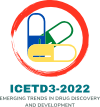Speaker
Description
Acacia auriculiformis Benth. has been traditionally known to cure various medical ailments such as sore eyes, allergy, rheumatism, and rashes. The present study was designed to confirm the wound healing efficacy of methanol leaves extract of A. auriculiformis. The leaves extracts were prepared in different solvents i.e., petroleum ether, chloroform, ethyl acetate, acetone, butanol, and methanol. The antidiabetic in-vitro assays were performed using α glucosidase and α amylase inhibition methods. The streptozotocin-induced diabetes model was used for 15 days study. The comparison study was carried out in diabetic wound control in respect of the period of epithelialization, % wound contraction, and hydroxyproline content in the excision wound model. However, the breaking strength parameter was used to calculate healing potential in the incision wound model. The bioactive methanol extract was subjected to LC-MS/MS analysis to characterize the phytoconstituents responsible for pharmacological activity. The methanolic leaves extract showed the highest percentage inhibition of 94.259% and 95.259% in α-glucosidase and α-amylase in-vitro antidiabetic assays, respectively. The high content of collagen fibers and stronger epithelial cells growth was observed in histopathological studies of hydrogel containing methanolic leaves extract as compared to the diabetic wound control and standard. Subsequently, for investigating the biological impact upon live cells, a cytotoxicity study was tested in different cell lines (A549, HEK293, and MCF7). Cytotoxic results showed that greater than 75% of cells were visible in all the cell lines, which gives the confirmation of the bio capability of the extract. The LC-MS/MS results revealed the presence of compounds such as β-sitosterol, lupeol, stigmasterol, and quercetin. A. auriculiformis is a potent medicinal plant that can be further utilized as a complementary and alternative therapy for the treatment of diabetes-induced wounds and the management of oxidative stress and diabetes.
